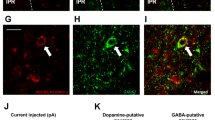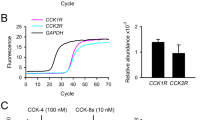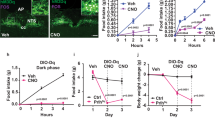Abstract
The brain hypothalamus contains certain secreted molecules that are important in regulating feeding behaviour1,2,3. Here we show that nesfatin, corresponding to NEFA/nucleobindin2 (NUCB2), a secreted protein of unknown function, is expressed in the appetite-control hypothalamic nuclei in rats. Intracerebroventricular (i.c.v.) injection of NUCB2 reduces feeding. Rat cerebrospinal fluid contains nesfatin-1, an amino-terminal fragment derived from NUCB2, and its expression is decreased in the hypothalamic paraventricular nucleus under starved conditions. I.c.v. injection of nesfatin-1 decreases food intake in a dose-dependent manner, whereas injection of an antibody neutralizing nesfatin-1 stimulates appetite. In contrast, i.c.v. injection of other possible fragments processed from NUCB2 does not promote satiety, and conversion of NUCB2 to nesfatin-1 is necessary to induce feeding suppression. Chronic i.c.v. injection of nesfatin-1 reduces body weight, whereas rats gain body weight after chronic i.c.v. injection of antisense morpholino oligonucleotide against the gene encoding NUCB2. Nesfatin-1-induced anorexia occurs in Zucker rats with a leptin receptor mutation, and an anti-nesfatin-1 antibody does not block leptin-induced anorexia. In contrast, central injection of α-melanocyte-stimulating hormone elevates NUCB2 gene expression in the paraventricular nucleus, and satiety by nesfatin-1 is abolished by an antagonist of the melanocortin-3/4 receptor. We identify nesfatin-1 as a satiety molecule that is associated with melanocortin signalling in the hypothalamus.
This is a preview of subscription content, access via your institution
Access options
Subscribe to this journal
Receive 51 print issues and online access
$199.00 per year
only $3.90 per issue
Buy this article
- Purchase on Springer Link
- Instant access to full article PDF
Prices may be subject to local taxes which are calculated during checkout




Similar content being viewed by others
References
Friedman, J. M. & Halaas, J. L. Leptin and the regulation of body weight in mammals. Nature 395, 763–770 (1998)
Schwartz, M. W. et al. Central nervous system control of food intake. Nature 404, 661–671 (2000)
Stanley, S., Wynne, K., McGowan, B. & Bloom, S. Hormonal regulation of food intake. Physiol. Rev. 85, 1131–1158 (2005)
Shimizu, H. & Mori, M. The brain–adipose axis: a review of involvement of molecules. Nutr. Neurosci. 8, 7–20 (2005)
Barnikol-Watanabe, S. et al. Human protein NEFA, a novel DNA binding/EF-hand/leucine zipper protein. Molecular cloning and sequence analysis of the cDNA, isolation and characterization of the protein. Biol. Chem. Hoppe-Seyler 375, 497–512 (1994)
Miura, K., Titani, K., Kurisawa, Y. & Kanai, Y. Molecular cloning of nucleobindin, a novel DNA-binding protein that contains both a signal peptide and a leucine zipper structure. Biochem. Biophys. Res. Commun. 187, 375–380 (1992)
Karabinos, A. et al. The divergent domains of the NEFA and nucleobindin proteins are derived from an EF-hand ancestor. Mol. Biol. Evol. 13, 990–998 (1996)
Lavoie, C., Meerloo, T., Lin, P. & Farquhar, M. G. Calnuc, an EF-hand Ca2+-binding protein, is stored and processed in the golgi and secreted by the constitutive-like pathway in AtT20 cells. Mol. Endocrinol. 16, 2462–2474 (2002)
Petersson, U. et al. Nucleobindin is produced by bone cells and secreted into the osteoid, with a potential role as a modulator of matrix maturation. Bone 34, 949–960 (2004)
Kanai, Y. et al. Natural occurrence of Nuc in the sera of autoimmune-prone MRL/lpr mice. Biochem. Biophys. Res. Commun. 196, 729–736 (1993)
Jia, D. M. et al. Troglitazone prevents and reverses dyslipidemia, insulin secretory defects, and histologic abnormalities in a rat model of naturally occurring obese diabetes. Metabolism 49, 1167–1175 (2000)
Zhou, A., Webb, G., Zhu, X. & Steiner, D. F. Proteolytic processing in the secretory pathway. J. Biol. Chem. 274, 20745–20748 (1999)
Duckert, P., Brunak, S. & Blom, N. Prediction of protein convertase cleavage sites. Protein Eng. Design Select. 17, 107–112 (2004)
Pritchard, L. E., Tumbull, A. V. & White, A. Pro-opiomelanocortin processing in the hypothalamus: impact on melanocortin signaling and obesity. J. Endocrinol. 172, 411–421 (2002)
Cone, R. D. Anatomy and regulation of the central melanocortin system. Nature Neurosci. 8, 571–578 (2005)
Phillips, M. S. et al. Leptin receptor missense mutation in the fatty Zucker rat. Nature Genet. 13, 18–19 (1996)
Fan, W. et al. Role of melanocortinergic neurons in feeding and the agouti obesity syndrome. Nature 385, 165–168 (1997)
Mountjoy, K. G. et al. Localization of the melanocortin-4 receptor (MC4-R) neuroendocrine and autonomic control circuits in the brain. Mol. Endocrinol. 8, 1298–1308 (1994)
Liu, H. et al. Transgenic mice expressing green fluorescent protein under the control of the melanocortin-4 receptor promoter. J. Neurosci. 23, 7143–7154 (2003)
Butler, A. A. et al. Melanocortin-4 receptor is required for acute homeostatic response to increased dietary fat. Nature Neurosci. 4, 605–611 (2001)
Taniguchi, N. et al. The postmitotic growth suppressor necdin interacts with a calcium-binding protein (NEFA) in neuronal cytoplasm. J. Biol. Chem. 275, 31674–31681 (2000)
Satoh, T. et al. Activation of peroxisome proliferator-activated receptor-γ stimulates the growth arrest and DNA-damage inducible 153 gene in non-small cell lung carcinoma cells. Oncogene 21, 2171–2180 (2002)
Tsuchiya, T., Shimizu, H., Horie, T. & Mori, M. Expression of leptin receptor in lung: leptin as a growth factor. Eur. J. Pharmacol. 365, 273–279 (1999)
Oh-I, S. et al. Molecular mechanisms associated with leptin resistance: n - 3 polyunsaturated fatty acids induce alterations in the tight junction of the brain. Cell Metab. 1, 331–341 (2005)
Acknowledgements
We thank M. Taguchi, M. Yoshiba and E. Kada for technical assistance, and K. Yoshikawa and M. Kojima for supplying mouse NUCB2 cDNA and developing ELISA, respectively. This work was supported in part by grants-in-aid from the Ministry of Health, Labor and Welfare of Japan (to M. Mori). Author Contributions S.O. and H.S. contributed equally to this work.
Author information
Authors and Affiliations
Corresponding author
Ethics declarations
Competing interests
Reprints and permissions information is available at www.nature.com/reprints. The authors declare no competing financial interests.
Supplementary information
Supplementary Figure 1
Northern blot of cell lysates using a 32P-labelled NUCB2 cDNA probe (bp 402– 967). (PDF 1459 kb)
Supplementary Figure 2
Effects of troglitazone (TGZ) on body weight in rats. (PDF 140 kb)
Supplementary Figure 3
Western blot of rat hypothalamic extracts using an affinity-purified NUCB2 Ab-L (1:1,600 dilution). (PDF 409 kb)
Supplementary Figure 4
Food intake in rats after icv injection of an anti-NUCB2 Ab-L. (PDF 57 kb)
Supplementary Figure 5
Putative processing sites of the rat NUCB2/nesfatin and Western blot using affinity-purified nesfatin Ab24 and Ab301. (PDF 201 kb)
Supplementary Figure 6
Elution profiles of rat hypothalamic extracts (a) and cerebrospinal fluid extracts (b) on HPLC. (PDF 323 kb)
Supplementary Figure 7
Western blot of fractionated samples of cerebrospinal fluid extracts on HPLC using an affinity-purified nesfatin Ab24. (PDF 276 kb)
Supplementary Figure 8
Immunohistochemical analysis of the rat hypothalamic Arc and PVN using a nesfatin Ab24. (PDF 172 kb)
Supplementary Figure 9
Changes in the fat weights after continuous icv injection of nesfatin-1. (PDF 74 kb)
Supplementary Figure 10
Hypothalamic NUCB2 concentrations (estimated by Western blot) 10 days after chronic icv injection of missense and antisense MON (daily 40 μg). (PDF 76 kb)
Supplementary Figure 11
Effects of alpha-MSH on NUCB2 gene expression in the hypothalamic PVN. (PDF 3496 kb)
Supplementary Figure 12
Effects of nesfatin-1 on expression of POMC, AgRP, NPY and CRH genes in the hypothalamic Arc and PVN. (PDF 1254 kb)
Supplementary Figure 13
Nesfatin-1-induced cAMP formation and calcium influx in cells expressing mouse MC3R or MC4R (PDF 89 kb)
Supplementary Notes
This file contains the Supplementary Methods and Supplementary Figure Legends. (DOC 37 kb)
Rights and permissions
About this article
Cite this article
Oh-I, S., Shimizu, H., Satoh, T. et al. Identification of nesfatin-1 as a satiety molecule in the hypothalamus. Nature 443, 709–712 (2006). https://doi.org/10.1038/nature05162
Received:
Accepted:
Published:
Issue Date:
DOI: https://doi.org/10.1038/nature05162
This article is cited by
-
Suppressive action of nesfatin-1 and nesfatin-1-like peptide on cortisol synthesis in human adrenal cortex cells
Scientific Reports (2024)
-
Nesfatin-1: A Biomarker and Potential Therapeutic Target in Neurological Disorders
Neurochemical Research (2024)
-
Effect of Boric Acid on Metabolic Peptides and Some Biochemical Parameters in Experimental Diabetic Rats
Biological Trace Element Research (2024)
-
NUCB2/Nesfatin-1 drives breast cancer metastasis through the up-regulation of cholesterol synthesis via the mTORC1 pathway
Journal of Translational Medicine (2023)
-
Nesfatin-1 suppresses autophagy of chondrocytes in osteoarthritis via remodeling of cytoskeleton and inhibiting RhoA/ROCK signal pathway
Journal of Orthopaedic Surgery and Research (2023)
Comments
By submitting a comment you agree to abide by our Terms and Community Guidelines. If you find something abusive or that does not comply with our terms or guidelines please flag it as inappropriate.



